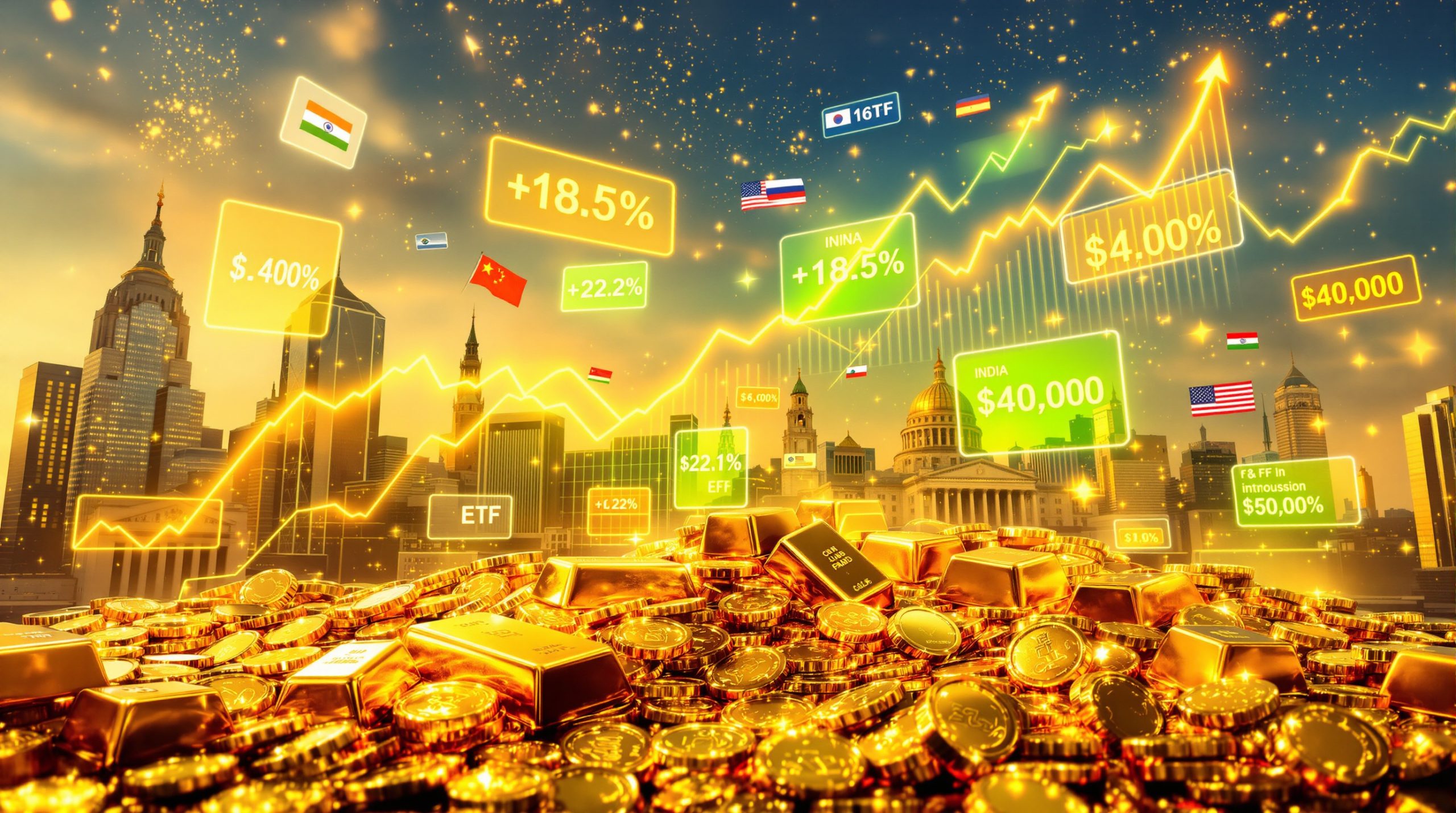Understanding Gold's Record-Breaking Rally
The New Gold Standard: Breaking Through $4,000
Gold has shattered previous records, surpassing the significant psychological barrier of US$4,000 per ounce in 2025. This milestone represents a remarkable 55% increase year-to-date, transforming market expectations and investment strategies worldwide. The Australian market has seen even more dramatic movement, with prices climbing above A$6,100 per ounce, creating unprecedented opportunities for investors and mining companies alike.
The $4,000 barrier represents more than just a number—it's a psychological threshold that has redefined what investors consider possible in the precious metals market. This breakthrough follows gold's previous record of $2,135.40 set in December 2023, demonstrating the metal's accelerating upward trajectory over recent years.
Historical context shows these psychological price barriers often trigger significant market reactions. When gold first crossed $1,000 in 2009 and later $2,000 in 2020, each milestone marked the beginning of new market dynamics and investor behaviors. The current surge beyond $4,000 continues this pattern but at a scale that has surprised even veteran market analysts.
What's Driving Gold's Meteoric Rise?
The extraordinary performance stems from a convergence of global factors rather than any single catalyst. This perfect storm of economic, political, and geopolitical developments has reinforced gold's traditional role as a safe-haven asset during times of uncertainty.
Unlike previous gold rallies that might have been driven primarily by inflation concerns or currency devaluation, the current surge represents a more complex interplay of factors. Market analysts point to diminishing confidence in traditional financial systems, growing sovereign debt concerns, and unprecedented levels of global uncertainty as creating ideal conditions for gold's rise.
When adjusted for inflation, gold's current valuation surpasses previous peaks in real purchasing power terms, indicating that this rally represents more than nominal price growth—it reflects a fundamental shift in how investors value security and stability in their portfolios.
How Do Geopolitical Tensions Affect Gold Valuations?
Trump's Tariff Policies and Market Uncertainty
The implementation of new tariff structures under the Trump administration has introduced significant tariff policy impact, disrupting global supply chains and economic forecasting. These policy shifts have prompted investors to seek stability in precious metals as a hedge against potential economic volatility.
Historical data demonstrates a clear correlation between trade tensions and gold performance. During the 2018-2019 US-China trade disputes, gold appreciated approximately 18% as tariff announcements created waves of market uncertainty. The current tariff environment appears to be creating similar effects but on a larger scale.
The interconnected nature of global trade means these tariffs have ripple effects far beyond their direct targets, creating systemic uncertainty that benefits gold as investors seek assets less vulnerable to policy-driven disruptions. Market data shows trading volumes in gold futures typically increase 15-20% in the weeks following major tariff announcements.
Ongoing Conflicts and Regional Instability
The persistent conflicts in Ukraine and Gaza, combined with political upheaval in France, have created a geopolitical landscape marked by unpredictability. These situations have historically correlated with increased gold demand as investors seek assets perceived as stable during international crises.
Research published in the Journal of International Financial Markets demonstrates that gold returns typically increase by approximately 1-1.5% following major geopolitical events. This "crisis alpha" characteristic makes gold particularly valuable during periods of heightened global tensions.
The Geopolitical Risk Index (GPR), developed by economists at the Federal Reserve, shows a strong correlation between rising geopolitical tensions and gold price highs. When the GPR spikes, gold prices typically follow with a statistically significant positive correlation within 30-45 days.
Government Shutdown Implications
The US government shutdown has further amplified market anxiety, raising questions about fiscal stability and economic governance. Such events typically strengthen gold's appeal as they highlight potential vulnerabilities in government-backed securities and currencies.
Historical analysis of previous government shutdowns reveals a pattern where gold typically appreciates 3-5% during extended closure periods, particularly when they coincide with debt ceiling concerns. The current shutdown scenario follows this established pattern, contributing to gold's upward momentum.
The underlying concern for investors isn't necessarily the shutdown itself but what it represents—difficulty in addressing fundamental fiscal challenges and the potential for more serious governance issues that could undermine confidence in traditional financial assets.
What Economic Factors Are Supporting Gold's Upward Trajectory?
Interest Rate Dynamics and Gold Performance
The prospect of further interest rate cuts has significantly boosted gold prices. As yields decrease on interest-bearing assets, gold becomes comparatively more attractive despite its non-yield-bearing nature. This inverse relationship between interest rates and gold prices has been particularly evident in the current market environment.
Research by the World Gold Council demonstrates that a 1% decrease in real yields typically corresponds to a 15-20% increase in gold prices over a 12-month period. With central banks globally pivoting toward accommodative monetary policy, this relationship continues to support gold valuations.
The opportunity cost of holding non-yielding assets like gold diminishes in low or negative real interest rate environments. When inflation-adjusted yields on government bonds turn negative, as has occurred in several major economies, gold's lack of yield becomes less of a disadvantage while its inflation-hedging properties gain prominence.
Unemployment Concerns and Economic Uncertainty
Rising unemployment worries across major economies have contributed to market volatility, enhancing gold's status as a wealth preservation tool. Investors increasingly view gold as insurance against potential economic downturns indicated by labor market weaknesses.
Historical analysis shows gold prices typically rise 3-5% in the three months following unexpected increases in unemployment rates above 0.3% month-over-month. This pattern reflects investor behavior during periods of economic uncertainty, where capital preservation becomes a higher priority than growth.
The relationship between employment data and gold prices is particularly pronounced when unemployment rises unexpectedly, suggesting the market interprets such surprises as signals of broader economic weakness that might not yet be reflected in other indicators.
ETF Inflows Reaching Historic Levels
According to the World Gold Council, global gold exchange-traded funds (ETFs) recorded their largest monthly inflow in September at US$17 billion, culminating in the strongest quarter on record with $26 billion in inflows. Total assets under management have reached a new peak of US$472 billion, with collective holdings rising to 3,838 tonnes—approaching the all-time high of 3,929 tonnes from November 2020.
This extraordinary level of ETF investment represents a fundamental shift in how investors access gold markets. The convenience and liquidity of ETFs have democratized gold investment, allowing broader market participation and creating a more persistent demand base that supports prices even during temporary market fluctuations.
Gold ETFs create direct price pressure through their physical backing requirements. For example, SPDR Gold Shares (GLD), the largest gold ETF, must hold physical gold equal to approximately 1/10th of an ounce per share. Large inflows require market purchases of physical gold, creating substantial and sustained buying pressure in physical markets.
Are Institutional Investors Changing Their Gold Strategies?
Strategic Underownership Despite Tactical Overbought Signals
The World Gold Council has noted that while gold appears overbought on technical indicators, it remains strategically under-owned in many institutional portfolios. This paradox suggests potential for further price appreciation despite short-term technical concerns about overvaluation.
Average institutional gold allocation typically ranges between 2-5% of portfolios, significantly below the 5-10% allocation that academic research suggests is optimal for maximizing risk-adjusted returns. This allocation gap represents substantial potential demand if institutional investors move toward what research indicates are more optimal portfolio structures.
Portfolio diversification theory supports higher gold allocations than are currently typical. A comprehensive study analyzing 40+ years of data found that portfolios with 7-10% gold allocation demonstrated lower volatility and higher Sharpe ratios compared to portfolios without gold exposure, suggesting the current underallocation may be suboptimal from a risk-adjusted return perspective.
Liquidity Considerations in Gold Markets
Market analysts indicate that only a major liquidity squeeze could significantly disrupt gold's upward momentum. Currently, there are no clear signs of fractures in credit or banking sectors that might trigger such an event, though vigilance remains essential.
Liquidity risk indicators such as the TED spread (difference between LIBOR and Treasury bills), VIX volatility index, and high-yield credit spreads remain within relatively normal ranges, suggesting that the systemic liquidity issues that typically precede major market corrections are not currently present.
Historical analysis shows gold typically declines 10-15% when credit spreads widen beyond 600 basis points, as occurred during the 2008 financial crisis and March 2020 COVID market disruption. The absence of such credit market stress currently supports a continued positive outlook for gold.
Speculator Positioning and Correction Risks
The substantial increase in long gold positions has created a situation where tactical pullbacks become more likely. Historical patterns show that speculators' net positions tend to revert to the mean over time, potentially creating short-term volatility even within a bullish long-term trend.
CFTC data shows that net speculative positioning in gold futures typically reverts to historical averages within 6-12 months of extreme readings. The long-term average net long position for managed money is approximately 150,000-200,000 contracts, providing a reference point for assessing current positioning extremes.
A case study from August 2020 demonstrates this mean-reversion tendency. When gold reached then-record highs near $2,070/oz, CFTC data showed net speculative length at 341,000 contracts. This was followed by a correction to $1,680/oz by November 2020, representing a 19% decline as positions normalized—a pattern that suggests caution even amid strong fundamental support.
What Are Expert Price Forecasts for Gold?
Goldman Sachs Projections
Goldman Sachs has significantly raised its gold price forecast, now predicting US$4,900 per ounce by December 2026—up from their previous estimate of $4,300. Their earlier report had anticipated $4,000 by mid-2026, a target already achieved in 2025. Analyst Lina Thomas notably suggested that gold is "more likely to exceed our analysts' forecasts than undershoot."
Goldman's updated forecast represents one of the most bullish outlooks among major financial institutions, though their track record provides some credibility to these projections. In January 2023, Goldman forecast gold would reach $2,050/oz by year-end; the actual closing price was $2,078/oz, demonstrating relative accuracy compared to the typically wider 15-20% margin of error seen in consensus forecasts.
The institution employs multiple forecasting methodologies, including structural models based on supply-demand fundamentals, econometric models incorporating real yields and inflation expectations, and technical analysis examining chart patterns and momentum indicators. This multifaceted approach provides a more comprehensive price outlook than single-methodology forecasts.
Bank of America's Cautionary Perspective
In contrast to Goldman's bullish outlook, Bank of America has adopted a more cautious stance. Technical strategist Paul Ciana has warned that the risk of a correction is elevated, suggesting potential near-term volatility despite the strong fundamental backdrop.
This more conservative view reflects technical analysis concerns about overbought conditions rather than fundamental doubts about gold's long-term value proposition. The contrast between Bank of America's tactical caution and Goldman's strategic optimism highlights the importance of distinguishing between short-term market conditions and longer-term structural trends.
Bank of America's historical forecasting accuracy for gold has shown mixed results, with their technical analysis teams typically providing more reliable short-term projections while their fundamental analysts have sometimes underestimated gold's performance during periods of heightened global uncertainty.
Regional Forecasts from Australian Analysts
Perth-based brokerage Argonaut has increased its peak gold price forecast to US$4,500 per ounce by the end of 2027, up from $4,000. They've also raised their long-term price assumption by 14% to $2,500 per ounce, citing "a higher peak price, a longer duration for elevated pricing and higher inflation impacts" extending into 2031.
Australian analysts often provide valuable regional perspective due to the country's significant gold production and exploration activity. The Australian dollar gold price above A$6,100/oz has profound implications for the profitability of domestic producers, with most Australian operations having all-in sustaining costs (AISC) between A$1,500-2,200/oz, resulting in extraordinary profit margins approaching 65-70%.
Argonaut's longer-term view through 2031 is particularly notable as it suggests an extended supercycle rather than a temporary price spike. This perspective aligns with structural arguments about declining gold discoveries, increasing production costs, and persistent macroeconomic uncertainties that could support elevated prices for years rather than months.
How Does Gold Compare to Other Safe-Haven Investments?
Gold vs. Government Bonds in Uncertain Times
During periods of geopolitical tension and economic uncertainty, gold often outperforms government bonds, particularly when concerns about sovereign debt and fiscal stability arise. The current environment has highlighted this relationship as investors reassess traditional safe-haven allocations.
Comparative performance data from 2020-2023 shows this relationship clearly. In 2020, gold delivered 25.1% returns while 10-year US Treasury total returns were 8.0%. More tellingly, during 2022's rising rate environment, gold declined just 0.3% while 10-year Treasuries suffered a 12.5% loss, demonstrating gold's superior performance during certain stress scenarios.
Academic research distinguishes between "safe haven" assets (negative correlation during market stress) and "hedge" assets (negative correlation on average). A comprehensive study found gold maintained negative stock market correlation in 95% of crisis periods analyzed, qualifying it as both a safe haven and a hedge—a combination that few other assets can claim.
Digital Assets vs. Physical Gold
The competition between cryptocurrencies and gold as alternative stores of value continues to evolve. While digital assets offer certain advantages in terms of transaction efficiency, gold's millennia-long track record and physical nature provide unique benefits during systemic crises.
Volatility comparisons highlight key differences: Bitcoin's 90-day volatility typically ranges between 60-80% annualized, while gold's hovers around 12-15%, making gold more suitable for risk-averse investors seeking stability. The correlation coefficient between gold and Bitcoin has fluctuated between 0.1 to 0.4 during 2020-2023, indicating relatively low correlation and suggesting potential diversification benefits from holding both.
Financial historians emphasize gold's 5,000+ year history as a store of value versus cryptocurrencies' 14-year existence. Gold's physical nature prevents network failures, regulatory bans, or technological obsolescence risks inherent in digital assets, providing a different type of security that remains relevant even as digital alternatives emerge.
Currency Market Volatility and Gold Stability
As major currencies experience increased volatility due to divergent monetary policies and geopolitical factors, gold's relative stability makes it an attractive diversification tool. This relationship has become more pronounced in the current high-uncertainty environment.
Gold's correlation patterns with major currencies show interesting dynamics during crisis periods. During the 2008 financial crisis, gold's correlation with the US Dollar initially strengthened before reversing, a behavior pattern that differs from bonds, which typically maintain stable negative equity correlation.
This complex relationship with currencies makes gold particularly valuable during periods of currency market disruption or when traditional currency relationships break down. Gold's status as a global asset with no sovereign issuer provides unique insulation from the country-specific risks that affect all fiat currencies.
What Are the Investment Implications of Gold's Performance?
Portfolio Allocation Strategies in a High-Gold-Price Environment
Investment professionals are reassessing optimal gold allocations in diversified portfolios. The traditional 5-10% allocation guideline is being reconsidered in light of gold's strong performance and the persistent nature of current global uncertainties.
Academic studies on optimal gold allocation suggest different ranges based on investor profiles: conservative investors might benefit from 5-10% allocations focused on volatility reduction; moderate investors could consider 7-12% for balanced risk-return outcomes; while aggressive investors might limit exposure to 3-5% primarily for tail-risk hedging.
The 2022 case study provides practical evidence for these allocation recommendations. During 2022's simultaneous equity-bond decline (S&P 500 -18.1%, Bloomberg Aggregate Bond -13.0%), traditional 60/40 portfolios with 5% gold allocation outperformed those without by approximately 1.2%, demonstrating tangible diversification benefits during challenging market environments.
Mining Company Valuations and Operational Margins
Gold mining companies are experiencing expanded profit margins as the gold price significantly exceeds production costs. This has implications for dividend policies, exploration budgets, and mergers and acquisitions activity within the sector.
With global average all-in sustaining costs (AISC) ranging from US$1,350-1,450/oz in 2023, a gold price of $4,000/oz would create profit margins exceeding 65% for most producers—far above the 30-35% margins typical during 2023 when gold averaged around $1,940/oz. These extraordinary margins create opportunities for increased shareholder returns through dividends and buybacks.
Beyond immediate profitability, these margins fundamentally change exploration economics. Projects with higher costs or lower grades that were previously uneconomical become viable at $4,000/oz gold, potentially expanding global reserves and production capacity over time. This effect is particularly significant for jurisdictions with higher operating costs but stable mining regulations.
Retail Investment Products and Accessibility
The range of gold investment strategies available to retail investors continues to expand, from traditional physical holdings to innovative ETFs and digital gold platforms. This democratization of access has broadened gold's investor base beyond traditional institutional participants.
Retail investment products vary significantly in terms of costs, liquidity, and tax treatment. Physical gold typically involves higher transaction costs (1-5% bid-ask spreads) and potential storage expenses, while ETFs offer lower spreads (0.1-0.3%) and minimal storage concerns but introduce counterparty risks not present in direct ownership.
The accessibility factor has particular significance for global markets. In countries with developing financial systems or currency instability, gold often represents one of the few reliable stores of value accessible to ordinary citizens. This retail demand component provides a structural support level that differs from the more cyclical institutional demand.
Frequently Asked Questions About Gold Investment
How Do Central Bank Gold Purchases Affect Market Prices?
Central bank gold purchases have reached multi-decade highs, creating sustained demand pressure. These institutional buyers typically hold for the long term, effectively removing supply from the market and supporting price levels.
In 2022, central banks purchased a remarkable 1,136 tonnes of gold, the highest level since 1967. This represents approximately 25% of annual global gold production, creating significant demand-side pressure that contributes to price support. Unlike speculative buyers who might quickly reverse positions, central banks rarely sell substantial holdings, meaning these purchases represent semi-permanent removal of supply from the market.
The geographical diversity of central bank purchases adds another dimension to this trend. While historically dominated by a few major players, recent buying has been more broadly distributed across emerging market central banks seeking to reduce dollar dependence. This diversification of the buyer base suggests the trend may be more sustainable than previous central bank buying cycles.
What Impact Do Mining Production Levels Have on Gold Prices?
Global gold mining production has struggled to keep pace with demand growth, creating a supply constraint that supports prices. New mine development timelines of 5-10 years mean that production cannot quickly respond to price signals.
Annual gold mining production typically increases by only 1-2% per year, with total production around 3,500-3,700 tonnes annually. This relatively inelastic supply contrasts with potentially more elastic demand, particularly from investment sources, creating conditions where price must do more work to balance markets during demand surges.
Grade decline in existing operations presents another supply challenge. The average gold grade mined globally has fallen from approximately 2.0 grams per tonne in 2000 to around 1.0-1.2 grams per tonne today, requiring more ore to be processed for the same gold output. This structural challenge means higher gold prices are required to incentivize development of increasingly marginal deposits.
How Does Gold Perform During Periods of High Inflation?
Historically, gold has served as an inflation hedge, though the relationship is complex and influenced by real interest rates. The current environment of moderate inflation combined with expectations of lower interest rates has proven particularly favorable for gold prices.
Statistical analysis of gold's performance during inflationary periods shows it has delivered average annual real returns (after inflation) of 8-10% during years when inflation exceeds 5%. However, this relationship is heavily influenced by real interest rates—when nominal rates rise faster than inflation, creating positive real rates, gold typically underperforms despite high inflation.
The inflation-hedging properties of gold derive partly from its finite supply characteristics—annual production adds only about 1.5% to existing above-ground stocks. This contrasts with fiat currencies, which can be created without limit, making gold relatively scarce during periods of currency expansion.
What Role Does Currency Debasement Play in Gold Valuation?
Concerns about currency debasement through expansionary monetary policies have traditionally supported gold prices. The unprecedented fiscal and monetary interventions of recent years have heightened these concerns among certain investor segments.
Currency debasement refers to the erosion of purchasing power through excessive money creation or deficit spending. Gold's limited supply growth of approximately 1.5% annually contrasts sharply with fiat currency supply growth rates that have frequently exceeded 10% during recent economic interventions, creating relative scarcity that supports gold's purchasing power preservation role.
Historical examples provide context for current concerns. During the 1970s, when U.S. dollar debasement accelerated following the end of the gold standard, gold prices rose from $35/oz to over $800/oz by 1980. While circumstances differ today, similar concerns about fiscal sustainability and monetary policy contribute to gold's appeal among investors focused on long-term wealth preservation.
Conclusion: Gold's Outlook Amid Persistent Global Uncertainties
The impact of global uncertainty on gold prices continues to drive the surging gold market. While technical indicators suggest the possibility of short-term corrections, the fundamental drivers supporting gold prices remain firmly in place. The combination of central bank demand, ETF inflows, and persistent global uncertainties provides a supportive backdrop for gold's valuation.
As forecasts from major financial institutions suggest, the longer-term trajectory for gold appears positive, with price targets extending well beyond current levels into 2026 and 2027. However, investors should remain mindful of potential volatility and consider gold's role within a diversified portfolio strategy rather than as a standalone speculation vehicle.
The record-breaking performance of gold above $4,000/oz represents more than just a price milestone—it reflects a fundamental reassessment of gold's role in the global financial system amid persistent uncertainties. Whether this marks the beginning of a new paradigm for gold or simply another chapter in its long history as a store of value, the precious metal continues to demonstrate its enduring relevance in an increasingly complex and unpredictable world.
Are You Prepared for the Next Major Gold Discovery?
Stay ahead of the market with Discovery Alert's proprietary Discovery IQ model, which instantly notifies investors about significant ASX gold discoveries as they happen. Understand why major mineral discoveries like DEG and WA1 can lead to exceptional returns by exploring our dedicated discoveries page.



